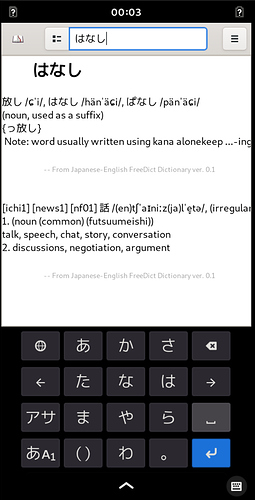I like this solution probably the best.
I’ve added a fancy Kana-only Japanese layout: https://source.puri.sm/Librem5/squeekboard/merge_requests/208
Japanese users, please test, and, even better, make fixes! The file can be downloaded here: https://source.puri.sm/Librem5/squeekboard/raw/06f99b85f0529679984c89c199ad39b6a3261466/data/keyboards/jp+kana.yaml?inline=false
All contributors: that keyboard might be interesting to you if you want to learn what tricks can be pulled off with your own keyboards. It’s quite different from all the others so far!
Thanks for the Kana-Keyboard @dcz, I’ll gladly take a look at it.
As I didn’t see a German layout around, I just made an initial version of a German keyboard layout, based on @uzanto’s work.
The first tests with tests/entry.py seem to be OK. As a next step I forked squeekboard and pushed the new de.yaml. What would be the next step? Waiting here for feedback and/or do a merge request?
EDIT: Here’s the Merge Request (MR 227) for the German layout.
Thank you!
The feedback process always starts with an issue/MR on source.puri.sm for all projects. Then people can review and comment, until the maintainers are pleased and merge it in.
This thread looks like an exception, but you might have noticed I’m not giving advice on particular keyboards, only explaining general concepts 
Two more keyboard layouts and the corresponding merge requests: A German keyboard layout derived from the other European keyboard layouts and a Japanese keyboard layout based on the work of @dcz, but with a 12-key Kana layout.
The files for the layouts can be downloaded here: de.yaml and ja+kana.yaml.
The German keyboard additionally includes most of the French accented characters, but there was not enough space for all of them - sorry.
The Japanese layout is a classic 12-key Kana layout with additional layers of Latin characters and numbers. Maybe it could be used as the basic keyboard layout for Kanji lookup in the future - but that’s still far away.
Please test the layouts and give feedback 
EDIT: Meanwhile, the two layouts have been merged - so there’s no need to download them manually any more. Nevertheless, I updated the links just in case.
I did finish testing the Russian layout and implemented the additional keys on the space bar row as @uzanto suggested. I created a merge request for this last week, just waiting on any feedback.
I like it! Thank you so much for working on this layout.
Please drop your likes on the GitLab link  We in the trenches don’t always monitor the forums closely, and decisions to merge are based on the comments under the merge requests.
We in the trenches don’t always monitor the forums closely, and decisions to merge are based on the comments under the merge requests.
And here’s a screenshot of the Japanese Kana keyboard layout in action with Gnome dictionary (Librem 5 QEMU image):
@dcz I took the time to find the layouts and noticed someone has done a swedish layout (se - shouldn’t it be sv as per standards?). It seems identical to the one finns would use for a touchscreen keyboard, so until a better layout manifests, could you possibly copy and use that for the fi layout as well approve the merge request made by @uzanto?
And big thanks to who ever made the swedish layout!
(edit: and concerning https://source.puri.sm/Librem5/squeekboard/issues/117, I suggest using this documentation for a guide for naming layouts/files: “languages-sublanguages-regions-…-special layouts” . Two letter language codes are based on ISO standard 3166 and given additional descriptions if needed (there are lists of languages of the world). Then it becomes identifiable and hierarchical, and additional new layouts (even non-standard) can be added later in a sane way without messing with the main languages/layouts by just adding an additional identifier/code after.)
What about UTF-8 ? It would solve many problems.
UTF-8 doesn’t apply to layouts, unfortunately.
If you post here the differences between layouts I’ll make the merge request.
No difference with se (which should be sv) touch keyboard. Just copy-paste-rename 
Thanks a lot @uzanto !
(I’ll update the list later).
Waiting for approval
We’re using GNOME’s way of naming input methods (the settings application lets people select layouts), so we’ll be following that unless it proves insufficient.
But I appreciate the links, they may come in handy in some unexpected moment.
Getting back to topic: do we have anyone working on for instance Chinese, Hebrew, Arabic or Russian inputs? The last one is probably easiest layout wise but still needs a native to work on it.
I created a Russian layout a few weeks back and submitted a merge request but it is outdated now due to breaking changes in the keyboard layout format. I’ve been meaning to resubmit this but I’ve had trouble getting Gnome Boxes to run the qemu image since I updated to Ubuntu 18.04. I hope to be able to get back to this soon.
Good to hear! I’ll mark that as “in the works”.
When you select the Swedish keyboard in the Region & Language panel in Settings, the se input source is enabled, so the keyboard needs to use that instead of sv. I don’t know why it uses se instead of sv - it’s just easier to go with it.

